
Coragulac House, Red Rock.
The 175-strong Rigby series of sketchbooks published between 1966 and 1982 is a collector’s favourite of hand-illustrated snapshots capturing Australian towns, regions and places of historic, architectural, geographic and cultural enterprise.
Everywhere from Tassie to the Yorke Peninsula, Sydney’s Rocks to Western Australia’s goldfields, gets a guernsey – in glorious monochrome pen, pencil and watercolour renderings.
Geelong was featured in a well-known 1971 edition, Geelong Sketchbook, by Les Blake and artist Desmond Norman. Its 30+ images include such institutions such as St Mary’s, Corio Villa, Eastern Beach, Osborne House, Point Henry, the Malop/Gheringhap roundabout and Kardinia House.
Less well-known is its sister tome, Western District Sketchbook, by Brian McKinlay and artist Graham Hawley, with its images across the “blue blood and green grass” reaches from Geelong to the Stony Rises, Camperdown to Portland.
Geelong, The Pivot, was a linchpin in the fortunes of many homesteads of the Western District, and this sketchbook provides an intriguing glimpse of properties rarely seen back in the 1970s, as well as clever snapshots of many places of interest.
These include piles such as Coragulac House, nestled among the Red Rock volcanic mounds outside Colac sometimes considered the area’s rain-gauges.
The bluestone Coragulac hosts cone towers, coloured glass windows, kauri and huon pine ceilings, cedar and mahogany doors, Italian marble fireplaces and a Cornish slate roof.
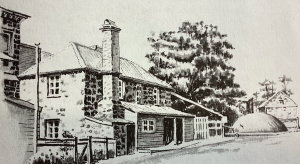
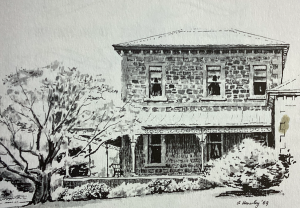
Tarndie at Warncoort.
Hawley’s pretty Cape Otway Lighthouse softens the harsh reality of the essential utility it played for ships negotiating the way along the Shipwreck Coast.
“I have seldom seem a more fearful section of coastline,” navigator Matthew Flinders wrote of what are some of the highest cliffs in Australia, rising out of the sea in unbroken walls of rock.
McKinlay agrees, writing that inshore reefs and prevailing westerlies made it doubly dangerous. The lighthouse was built after the worst-ever Australian maritime disaster at the time, when the Cataraqui broke in two on the rocks of King Island in 1845, drowning 406 souls.
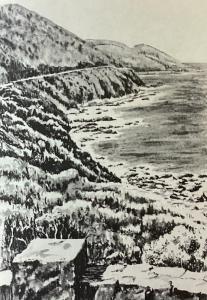
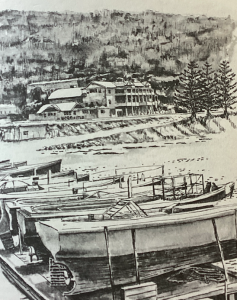
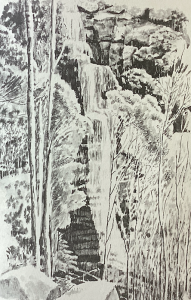
Cinema Point, the Grand Pacific Hotel, Erskine Falls.
A somewhat happier story is that of the Pacific Hotel at Lorne’s Point Grey, originally the Grand Pacific when it was built for the Gwynee family in the 1870s. As McKinlay relates:
“In the early days, it was very difficult to travel to Lorne. But the little resort always seemed especially attractive to holiday-makers, so there was a flood of tourists when the railway reached Winchelsea, although there was still a six-hour coach journey through the Otway Ranges. The first hotel offered welcome comfort and rest to such tourists.”
Cinema Point on the Great Ocean Road and Erskine Falls upstream from Lorne are two long-popular tourist attractions featured in the sketchbook.
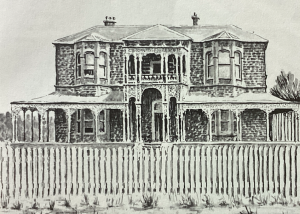
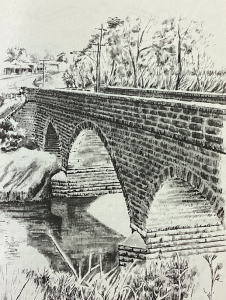
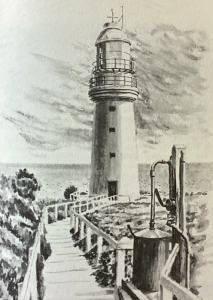
Barwon Park, Barwon Bridge, Winchelsea, Cape Otway Lighthouse.
The bluestone Barwon Bridge at Winchelsea is likened to Richmond’s bridge in Tasmania, where settlers in the area originated. It was opened by the Duke of Edinburgh in 1867.
Curiously, the bridge had hardly been completed when a row arose over purported structural imperfections and concerns the bridge might collapse. But the bridge has long outlasted its critics, McKinlay reminds us.
The nearby Barwon Park homestead, or “the warren” as it was nicknamed after its builder Thomas Austin had his imported rabbits propagate massively out of control, features alongside various other substantial properties: Ingleby at Winch also, Tarndie at Warncoort, Purrumbeete and Talindert, near Camperdown, and further afield with Larra and Monivae and across to Portland’s Burswood.
Pubs, banks, quays, coast gorges, mills and churches also find their way into this collection, which all up is a great little travel guide. Keep your eyes peeled for one in the second-hand bookshops.
This article appeared in the Geelong Advertiser 1 January 2024.


